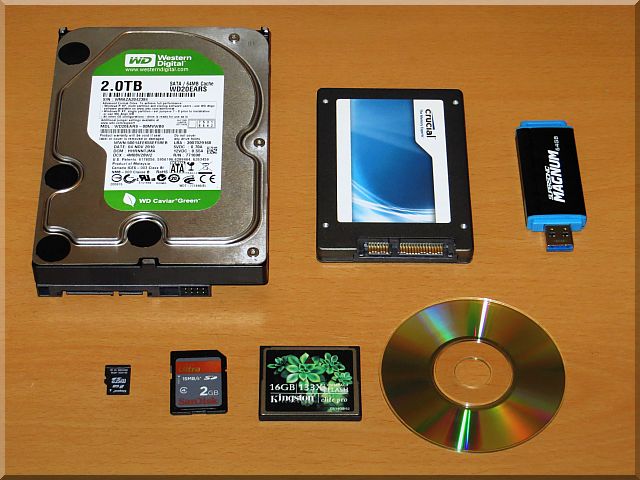For about a century the photographic film was the main storage medium used to preserve the images from the moment they were captured to the moment they were transferred to photographic paper through a fairly complex chemical and optical process. Such a long history of widespread use produced around a trillion pictures in the world. Like other photographers (amateurs or not) I had my own contribution to this number shooting on film for about 25 years before switching to digital.
With the start of the 21st century, the digital revolution produced a significant shift in the way we store our memories. Borrowed from the computer technology, sounds and images began to be digitized (using numbers to represent information) on a large scale in devices like digital audio recorders, digital cameras or digital video recorders. In order to store the digital information, computers use different types of memories (computer data storage). Long term storage devices and digital media, based on various natural phenomena, have been created; unfortunately, there is no universal storage medium that can satisfy every requirement of a practical application. Currently, the digital devices from computers to cameras or to media recorders and players use several kinds of storage (for example, magnetic disks, optical disks, solid-state or semiconductor memory cards).
With few exceptions, the vast majority of modern digital cameras use flash memory cards (a type of solid-state memory that can be electrically erased and reused). Like any other type of persistent (non-volatile) memory, flash memory has certain advantages that make it suitable to portable devices: small physical size, available in a wide range of storage capacities, good operational performance (speed), no moving mechanical parts and reasonable cost. On the other hand, there are some disadvantages that we cannot ignore: the data retention time is relatively short (less than 10 years for most cards), cannot be used for archival (we need to transfer data from cards to a long term storage device), sensitive to static and electrical shock and it can be accidentally erased (or partially corrupted) by misuse.
The most important parameters of a digital memory card are:
- Capacity measured in bytes (1 byte = 8 bits, one bit can store just two values 0 or 1) and usually expressed in MB (1024 KB) and GB (1024 MB). Many compact cameras produce images requiring 1…4 MB which means that a 2 GB card can store between 500 to 2000 photos. Most consumer DSLRs require 10…20 MB per image – i.e. the same 2 GB card will store only 100 to 200 images.
- Speed is normally measured in MB per second (MB/s) but sometimes the manufacturers use different systems to indicate this parameter. CF cards use the “x” factor that represents essentially the same factor used in qualifying the speed of CD-ROM units: 1x represents 150 KB/s. For example, 133x = 150 KB/s * 133 ≈ 20 MB/s. SD cards may also use the Speed Classdefined as the minimum performance to record video:
- class 2 is for SD video recording (2 MB/s),
- class 4 and 6 are for HD video recording (4 and, respectively 6 MB/s),
- class 10 is for full HD video recording (10 MB/s).
Please note that the “x” factor characterizes the maximum speed under ideal conditions while the Speed Class indicates the minimum guaranteed performance for recording (writing data).
- Endurance represents the number of erase cycles the card supports without the danger of unreliable operation. This parameter is not often disclosed and it is somewhat difficult to be understood by the general public because “erasing” happens transparently when the data is written to the flash card. One may estimate this parameter as the number of times the card is completely filled with images and the card then reused (by deleting all the images or formatting the card). If not known, a typical number is around 1000 cycles; while the number looks small, multiply this number by the average number of images the card can hold and you will get quickly in the vicinity of 1,000,000 captures. Does it look like a small number? Well, remember that many cameras have a life of 25,000 to 100,000 shutter releases – the card will probably outlast the camera!
- Data Retention Time is another parameter less known to public and it represents the minimum guaranteed time interval that the data will be preserved intact on the card without degradation (if the card is not used). Without any information you can assume an average retention time of 3…5 years in conditions of normal usage (typical amateur photographer). In the best case scenario (card only used few times) this interval may increase to 10…20 years (see this article for more examples in non-photographic circumstances). As consequence, don’t use the flash cards for archival; consider them as a temporary storage media and use other methods for long term storage.
Most cards will come with (limited or full) lifetime warranty. Please do not make the assumption that these cards are good for archival, except when the manufacturer explicitly mentions the data retention time or indicates “for archival purposes“. But even in these circumstances I would backup my photos on a different media.
Also, while the endurance can be high, the lifetime warranty does not mean infinite. Eventually, after a number of cycles the cards will begin to show the wear by corrupting data occasionally; a lifetime warranty only means that, statistically, this phenomenon is very unlikely to happen for a long period of time assuming a reasonable use. So, please backup your photos as soon and as often as you can no matter the warranty of the card.
In the next post I will insist a bit more on each type of card used in modern digital cameras. While this discussion seems to be an interruption in the London vacation series, I consider that adding a technical post from time to time is still useful in the large context of knowing your photographic gear.

